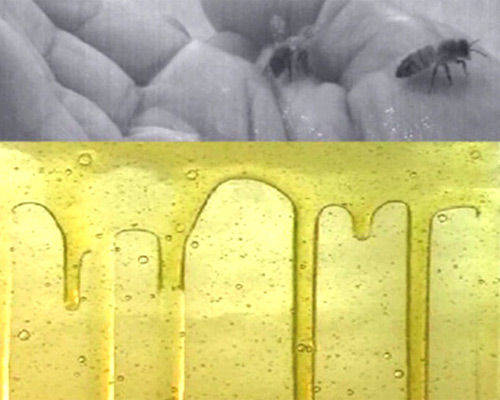Bees at a still edge: Trish Adams, by Michele Helmrich

Michele Helmrich,
catalogue essay from Trish Adam’s DVD installation “HOST”,
6 March-6 April, The Univeristy of Queensland Art Museum, http://artmuseum.uq.edu.au
In Trish Adams’s moving image work HOST, bees demand our attention. They are magnified many times over and are screened large and in slow motion. Bees fly toward the undulating surface of a human hand; discover its surface of sweet honey, and feed. The human hand – the artist’s hand – stays still and does not flinch. The artist tells how, when developing this work, she stood in the ‘bee house’ without protection and vulnerable. Discovering this performative dimension, we navigate the work differently.
The ‘bee house’ is not the hive with the shrouded beekeeper. The ‘bee house’ sounds grand, as if a place of wonder. Perhaps the ‘bee house’ if visited would physically disappoint, but wonder is to be found in the research that is conducted at the ‘bee house’ in the Queensland Brain Institute (QBI) at The University of Queensland. Studies conducted by Professor Mandyam Srinivasan and his colleagues have demonstrated the remarkably advanced capacities of small animals such as the honeybee and other flying insects, particularly in terms of flight control and navigation. Findings that honeybees can exhibit ‘associative recall’ – an ability likely to help the bee return to a food source; distinguish ‘similar’ objects; use scent to help trigger navigational memories; and be trained to detect camouflaged objects, are all of value to this work.1
During her residency at the QBI, Adams ‘trained’ bees to feed from her hand. Bees learned how to navigate to this food source: honey placed on the palm of her hand provided a scent, with ‘associative recall’ perhaps triggering a visual memory for return visits. The viewer watching the artwork, of course, does not witness this learning process. After all, this is not a wildlife documentary. Neither is the viewer provided with visual clues to help decipher the scientific research that, in a sense, augments the work. The viewer merely sees bees landing on a hand; the hand sometimes close-up and abstracted, and sometimes not. Indeed, the moving image could be mistaken for film documenting an experiment, removed from accompanying data.
But return to the bare flesh, the honey and the bees; the bees on bare, unprotected flesh. With this thought in mind, the viewer might empathise with the artist. We are cautious in the presence of bees. One sting and we learn to give them space. Inviting bees to sit on one’s hand appears like a formula used for overcoming a phobia. The bees’ navigational memory is secondary in this scenario, giving way to a focus on the psychological resilience of the hand’s owner. The artist admits that ‘initial vulnerability gave way to a sense of close engagement’ as contact with the bees provided a fresh focus.2 Once fear is reigned in, the object of our fear is looked at anew.
Yet is that the full story? All we see of the artist is her hand and her hand remains still. Much more attention is afforded to the bees. Shot in grey-scale, a scientific focus infuses the work. Seeing the bees so magnified and in such slow motion engages our curiosity. We might join with the scientists in observing how the bees land on flat surfaces; their fat bodies strangely awkward and hesitant. We might imagine the flutter of wings above skin, sense the vulnerability of these clumsy creatures, and, perhaps, consider the parallels between their working lives and our own, navigating paths in environments which are fruitful, hazardous and ever challenging.
Beth Jackson once wrote that, in Trish Adams’s artwork, ‘its mimicry of science is multi-dimensional – genuinely critical, humorous and ironic, and full of technical fascination’.3 HOST builds on a body of work which has sought interactive and collaborative engagement with science. Her doctoral project, ‘Changing Fates: an exploration of biomedical transformations’, saw her collaborating with Dr Victor Nurcombe of the School of Biomedical Sciences at The University of Queensland to produce a work that not only utilised her own cells, but also incorporated spectator involvement.4 HOST is not as ambitious in its scientific processes or in terms of interactive engagement with the viewer, but it does reflect a similar genuine concern with cutting-edge scientific enquiry and for the biological bases for interconnectivity, in this case between bees and humans.
Finally, the slow motion aspect of HOST inflects the work with a quality which is in part contemplative, and in part buoyed with the prospect of a thousand ideas, a thousand other ways of understanding the world. Ranulph Glanville has spoken of the way that ‘the digital allows us to slow down motion’, and in doing so creates an ambiguity that allows an ‘edge of stillness’. As Glanville argues, ‘This edge is the liminal. The experience is a sort of edgy trance.’5 Such a state of indeterminacy and disorientation may well be what is offered as we gaze at these slow moving creatures that hover on the threshold of our understanding. How we understand ourselves may well be what is thrown into question.
1. For further details of Professor Mandyam Srinivasan and his colleagues, see the Visual Neuroscience website: http://www.qbi.uq.edu.au/index.html?page=52793.
2. Trish Adams, Host: artist statement, 2007.
3. Beth Jackson, ‘Temporal intervals’, in Temporal intervals: Trish Adams, exhibition catalogue, The Brisbane Powerhouse, 2003.
4. Trish Adams, “Changing Fates: an exploration of biomedical transformations” in Proceedings of perthDAC 2007, The 7th International Digital Arts & Culture Conference, Hutchison, A. (ed.), Curtin University of Technology: Perth, Sept. 15-18, 2007, pp. 11-20.
5. Ranulph Glanville, ‘The edge of stillness’, Abstract for ‘Stillness: CADE 2007: Computers in art and design education’ Conference, Perth, 12-14 September 2007, http://cedar.humanities.curtin.edu.au/conferences/cade/pdf/CADE_STILLNESS.pdf.